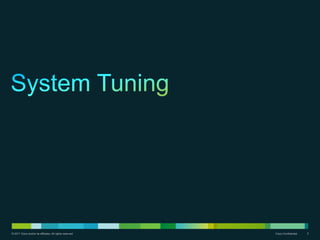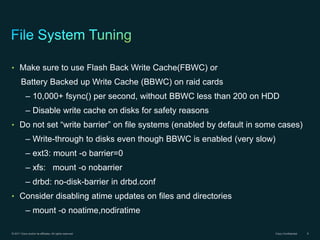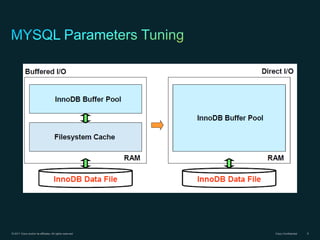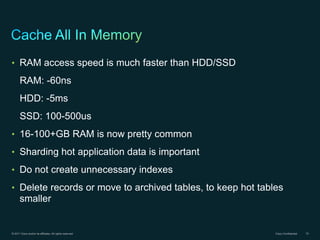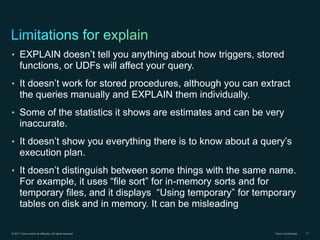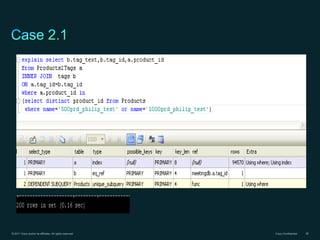Mysql performance tuning
- 1. MYSQL Performance Tuning Philip Zhong © 2011 Cisco and/or its affiliates. All rights reserved. Cisco Confidential 1
- 2. © 2011 Cisco and/or its affiliates. All rights reserved. Cisco Confidential 2
- 3. © 2011 Cisco and/or its affiliates. All rights reserved. Cisco Confidential 3
- 4. • Types of I/O schedulers (introduced in 2.6.10: RHEL5) – noop: Sorting incoming i/o requests by logical block address, that’s all – deadlilne: Prioritize read (sync) requests rather than write requests (async) to some extent (to avoid “write-starving-reads” problem) – cfq(default): Fairly scheduling i/o requests per i/o thread – anticipatory: Removed in 2.6.33 (bad scheduler. Don’t use it) • Default is cfq, but noop / deadline is better in many cases # echo noop > /sys/block/sdX/queue/scheduler © 2011 Cisco and/or its affiliates. All rights reserved. Cisco Confidential 4
- 5. © 2011 Cisco and/or its affiliates. All rights reserved. Cisco Confidential 5
- 6. • Make sure to use Flash Back Write Cache(FBWC) or Battery Backed up Write Cache (BBWC) on raid cards – 10,000+ fsync() per second, without BBWC less than 200 on HDD – Disable write cache on disks for safety reasons • Do not set “write barrier” on file systems (enabled by default in some cases) – Write-through to disks even though BBWC is enabled (very slow) – ext3: mount -o barrier=0 – xfs: mount -o nobarrier – drbd: no-disk-barrier in drbd.conf • Consider disabling atime updates on files and directories – mount -o noatime,nodiratime © 2011 Cisco and/or its affiliates. All rights reserved. Cisco Confidential 6
- 7. © 2011 Cisco and/or its affiliates. All rights reserved. Cisco Confidential 7
- 8. • Put sequentially written files on HDD – ibdata, ib_logfile, binary log files – HDD is fast enough for sequential writes – Write performance deterioration can be mitigated – Life expectancy of SSD will be longer • Put randomly accessed files on SSD – *ibd files, index files(MYI), data files(MYD) – SSD is 10x -100x faster for random reads than HDD – Archive less active tables/records to HDD – SSD is still much expensive than HDD • Use 5.1 InnoDB Plugin – Higher scalability & concurrency matters on faster storage © 2011 Cisco and/or its affiliates. All rights reserved. Cisco Confidential 8
- 9. © 2011 Cisco and/or its affiliates. All rights reserved. Cisco Confidential 9
- 10. • RAM access speed is much faster than HDD/SSD RAM: -60ns HDD: -5ms SSD: 100-500us • 16-100+GB RAM is now pretty common • Sharding hot application data is important • Do not create unnecessary indexes • Delete records or move to archived tables, to keep hot tables smaller © 2011 Cisco and/or its affiliates. All rights reserved. Cisco Confidential 10
- 11. • Network • CPU • …… © 2011 Cisco and/or its affiliates. All rights reserved. Cisco Confidential 11
- 12. © 2011 Cisco and/or its affiliates. All rights reserved. Cisco Confidential 12
- 13. © 2011 Cisco and/or its affiliates. All rights reserved. Cisco Confidential 13
- 14. © 2011 Cisco and/or its affiliates. All rights reserved. Cisco Confidential 14
- 15. © 2011 Cisco and/or its affiliates. All rights reserved. Cisco Confidential 15
- 16. • EXPLAIN SELECT – Tells you what MYSQL is thinking – Which keys (indexes) can it use – Which keys will it use – How many rows must it examine (roughly) © 2011 Cisco and/or its affiliates. All rights reserved. Cisco Confidential 16
- 17. • EXPLAIN doesn’t tell you anything about how triggers, stored functions, or UDFs will affect your query. • It doesn’t work for stored procedures, although you can extract the queries manually and EXPLAIN them individually. • Some of the statistics it shows are estimates and can be very inaccurate. • It doesn’t show you everything there is to know about a query’s execution plan. • It doesn’t distinguish between some things with the same name. For example, it uses “file sort” for in-memory sorts and for temporary files, and it displays “Using temporary” for temporary tables on disk and in memory. It can be misleading © 2011 Cisco and/or its affiliates. All rights reserved. Cisco Confidential 17
- 18. © 2011 Cisco and/or its affiliates. All rights reserved. Cisco Confidential 18
- 19. © 2011 Cisco and/or its affiliates. All rights reserved. Cisco Confidential 19
- 20. SIMPLE:Simple SELECT (not using UNION or subqueries) PRIMARY: outer select. UNION:Second or later SELECT statement in a UNION DEPENDENT UNION:Second or later SELECT statement in a UNION, dependent on outer query UNION RESULT:Result of a UNION. SUBQUERY:First SELECT in subquery DEPENDENT SUBQUERY: First SELECT in subquery, dependent on outer query DERIVED:Derived table SELECT (subquery in FROM clause) UNCACHEABLE SUBQUERY:A subquery for which the result cannot be cached and must be reevaluated for each row of the outer query UNCACHEABLE UNION:The second or later select in a UNION that belongs to an uncacheable subquery (see UNCACHEABLE SUBQUERY) © 2011 Cisco and/or its affiliates. All rights reserved. Cisco Confidential 20
- 21. © 2011 Cisco and/or its affiliates. All rights reserved. Cisco Confidential 21
- 22. © 2011 Cisco and/or its affiliates. All rights reserved. Cisco Confidential 22
- 23. • Mysql>SET profiling = 1; • Mysql>SHOW PROFILES; • Mysql>SHOW PROFILE CPU FOR QUERY 1; © 2011 Cisco and/or its affiliates. All rights reserved. Cisco Confidential 23
- 24. © 2011 Cisco and/or its affiliates. All rights reserved. Cisco Confidential 24
- 25. select tag_id,tag_text from Tags where tag_id+1>1 and tag_id+1<11; © 2011 Cisco and/or its affiliates. All rights reserved. Cisco Confidential 25
- 26. © 2011 Cisco and/or its affiliates. All rights reserved. Cisco Confidential 26
- 27. © 2011 Cisco and/or its affiliates. All rights reserved. Cisco Confidential 27
- 28. © 2011 Cisco and/or its affiliates. All rights reserved. Cisco Confidential 28
- 29. © 2011 Cisco and/or its affiliates. All rights reserved. Cisco Confidential 29
- 30. © 2011 Cisco and/or its affiliates. All rights reserved. Cisco Confidential 30
- 31. Thank you. © 2011 Cisco and/or its affiliates. All rights reserved. Cisco Confidential 31
Editor's Notes
- #5: 1)AnticipatoryThe anticipatory I/O elevator was created based on the assumption of a block device withonly one physical seek head (for example a single SATA drive). The anticipatory elevatoruses the deadline mechanism described in more detail below plus an anticipationheuristic. As the name suggests, the anticipatory I/O elevator “anticipates” I/O andattempts to write it in single, bigger streams to the disk instead of multiple very smallrandom disk accesses. The anticipation heuristic may cause latency for write I/O. It isclearly tuned for high throughput on general purpose systems such as the averagepersonal computer. Up to kernel release 2.6.18 the anticipatory elevator is the standardI/O scheduler. However most Enterprise Linux distributions default to the CFQ elevator.2)Complete Fair Queuing (CFQ)The CFQ elevator implements a QoS (Quality of Service) policy for processes bymaintaining per-process I/O queues. The CFQ elevator is well suited for large multiusersystems with a lot of competing processes. It aggressively attempts to avoid starvation ofprocesses and features low latency. Starting with kernel release 2.6.18 the improved CFQelevator is the default I/O scheduler.Depending on the system setup and the workload characteristics, the CFQ scheduler canslowdown a single main application, for example a massive database with its fairnessoriented algorithms. The default configuration handles the fairness based on processgroups which compete against each other. For example a single database and all writesthrough the page cache (all pdflush instances are in one pgroup) are considered as asingle application by CFQ that could compete against many background processes. It canbe useful to experiment with I/O scheduler subconfigurations and/or the deadlinescheduler in such cases.3)DeadlineThe deadline elevator is a cyclic elevator (round robin) with a deadline algorithm thatprovides a near real-time behavior of the I/O subsystem. The deadline elevator offersexcellent request latency while maintaining good disk throughput. The implementation ofthe deadline algorithm ensures that starvation of a process cannot occur.4)NOOPNOOP stands for No Operation, and the name explains most of its functionality. TheNOOP elevator is simple and lean. It is a simple FIFO queue that does not perform anydata ordering. NOOP simply merges adjacent data requests, so it adds very low processoroverhead to disk I/O. The NOOP elevator assumes that a block device either features itsown elevator algorithm such as TCQ for SCSI, or that the block device has no seek latencysuch as a flash card.
- #7: A write barrier is a kernel mechanism used to ensure that file system metadata is correctly written and ordered on persistent storage, even when storage devices with volatile write caches lose power.The disk contains all the data. No re-ordering has occurred. With barriers enabled, an fsync() call will also issue a storage cache flushWhen a write hits in a cache, two possible policy choices exist. First, the data can be writtenboth into the cache and passed on to the next lower level in the memory hierarchy. This policy iscalled write-through. A second possible policy on write hits is to only write the data to thefirst-level cache. Only when a dirty line (i.e., a line that has been written to) is replaced in thecache is the data transferred to a lower level in the memory hierarchy. This policy is calledwrite-back.

